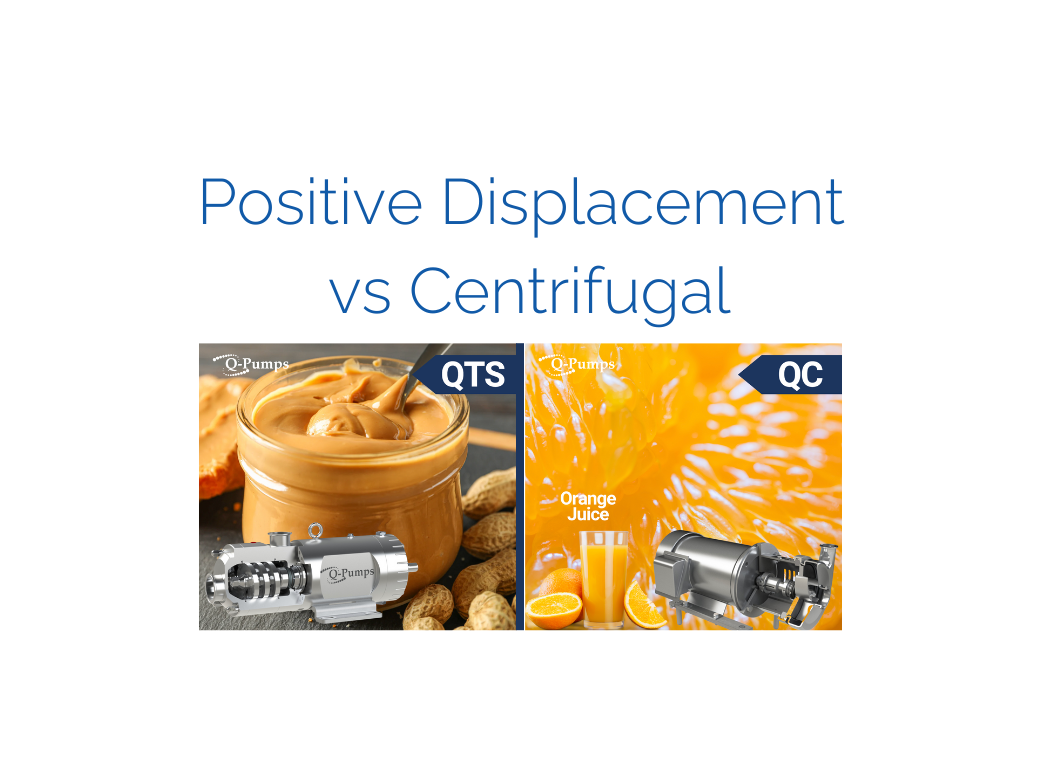Positive Displacement Pump vs Centrifugal Pump: Key Differences for Sanitary Industries
May 23, 2025

Compare positive displacement pumps and centrifugal pumps for sanitary food, beverage, cosmetics & pharma uses in this in-depth guide.
In food, beverage, cosmetics and pharmaceutical plants, choosing the right pump is crucial. A positive displacement pump vs centrifugal pump decision depends on fluid properties (viscosity, solids, shear sensitivity) and process needs (flow, pressure, hygiene). Positive displacement pumps trap and push a fixed volume of fluid per cycle, delivering a constant, pressure-independent flow. In contrast, centrifugal pumps use a spinning impeller to impart kinetic energy, producing flow that varies with backpressure. These fundamental differences guide pump selection in sanitary processing.
How Positive Displacement Pumps Work
Positive displacement (PD) pumps move fluid by mechanically trapping a fixed volume and forcing it from inlet to outlet. Rotary lobe or gear pumps trap liquid between their gears or lobes and displace it into the pipeline without backflow, yielding a smooth, consistent output. Because PD pumps meter a precise volume per revolution or stroke, their flow rate is directly proportional to pump speed and largely independent of system pressure.
Visualize QTS brochure
How Centrifugal Pumps Work
Centrifugal pumps operate on a different principle. A centrifugal pump draws fluid into the center of a rotating impeller and throws it outward by centrifugal force. The moving fluid’s velocity converts to pressure in the volute or diffuser, pushing liquid out the discharge. Because they rely on imparting energy to create pressure, a centrifugal pump’s flow depends heavily on system pressure.
Visualize Our centrifugal pump: QC Applications
Performance Comparison: Flow, Pressure and Viscosity
The most telling differences appear in how each pump handles pressure and fluid viscosity:
- Flow vs Pressure: A PD pump delivers nearly constant flow as pressure changes, whereas a centrifugal pump’s flow drops off.
- Viscosity Handling: Positive displacement pumps are inherently suited for thick, viscous fluids. Centrifugal pumps suffer when viscosity rises.
- Efficiency and Power: PD pumps tend to have high volumetric efficiency. Centrifugal pumps lose efficiency off-peak.
- Suction Lift: PD pumps can self-prime; centrifugal pumps cannot.
- Shear and Delicacy: PD pumps are gentler on shear-sensitive fluids.
Sanitary Design and Clean-in-Place (CIP)
Hygiene is paramount in food, beverage, cosmetics and pharma. Both pump types can be built to sanitary standards, but PD pumps often feature easy-clean designs and are more suited for handling viscous or shear-sensitive fluids in hygienic applications.
Applications in Food, Beverage, Cosmetics and Pharma
Food & Beverage: Centrifugal pumps are ideal for water or juice; PD pumps are better for syrups, pastes, or chocolate.
Cosmetics: Creams and gels require gentle PD pumps.
Pharma: PD pumps provide precise dosing and sanitary containment.
Maintenance and Operating Considerations
Centrifugal pumps are simpler and cost-effective for easy fluids. PD pumps may require more maintenance but provide better handling for demanding fluids.
Selecting the Right Pump: Key Factors
To decide between pump types, consider:
- Fluid viscosity and contents
- Flow and pressure
- Shear sensitivity
- Sanitary requirements
- Installation and maintenance
- Cost and efficiency
Sanitary Pumps: How to Choose the Right One?
Comparison Table
|
Feature |
Positive Displacement Pump |
Centrifugal Pump |
|
Flow vs Pressure |
Flow is constant regardless of backpressure. |
Flow drops as pressure increases. |
|
Viscosity |
Handles high-viscosity fluids well. |
Struggles with viscous fluids. |
|
Efficiency |
High volumetric efficiency. |
Efficient only near design point. |
|
Suction Lift |
Can self-prime. |
Requires flooded suction. |
|
Shear |
Low shear, gentle on product. |
High shear, may damage product. |
Understanding the differences between positive displacement and centrifugal pumps is essential for sanitary processing. PD pumps deliver constant flow and handle viscous or sensitive fluids. Centrifugal pumps are ideal for high flow, low-pressure tasks with clean fluids. Select the right type based on your process conditions for maximum efficiency and hygiene.
Request free technical consultation |